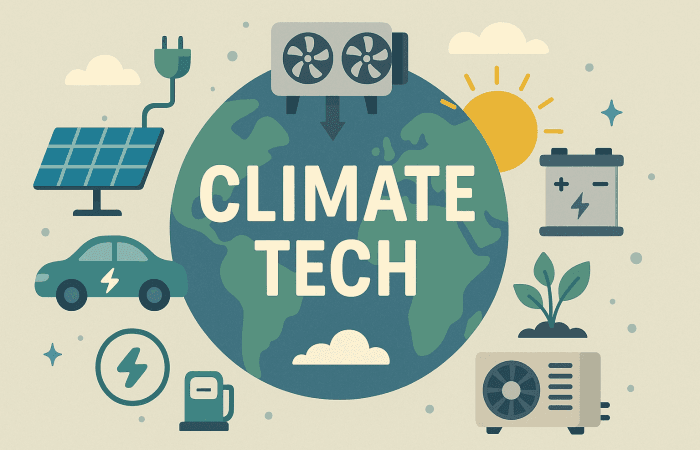What Is Climate Tech And Why It Matters
Climate tech is no longer just a futuristic idea, it is active now and it brings science, policy, and business together to tackle one of the greatest challenges of our time: climate change.
So, What Actually Is Climate Tech?
Put simply, climate tech covers any technology built to tackle climate change head-on and reduce greenhouse gas (GHG) emissions. That means cutting emissions, removing carbon from the atmosphere, or helping us adapt to more extreme weather. And you’ll find it across energy, transport, agriculture, industry – and in just about every major sector.
If it’s designed to cool the planet or help us cope with the heat, it probably fits under the climate tech umbrella.
Climate tech is already shifting how entire sectors work. The International Energy Agency estimates that nearly half of the emissions cuts we’ll need to hit net-zero by 2050 will come from tech that is still in early stages of prototype or demonstration. So, getting this right matters.
Is Climate Tech the Same as Green Tech and Clean Tech?
Not quite.
Green Tech
Green tech is the broader category – it includes anything that benefits the environment, like wildlife conservation tools or water treatment systems. Climate tech sits inside that, but with a sharper focus on reducing or responding to climate change specifically. If green tech is the whole garden, climate tech is the section designed specifically to cool the planet.
Clean Tech
Clean tech, on the other hand, is often used when talking about things like renewable energy or waste reduction. In other words, it’s focused on general sustainability. Clean tech overlaps with climate tech, but not everything labelled as clean tech is focused solely on climate change. While all climate tech can be considered clean, the reverse isn’t always true.
Climate tech is more targeted. It specifically tackles the causes and effects of climate change, such as cutting greenhouse gas emissions or helping communities adapt to extreme weather.
Examples of Climate Tech (And What They Do)
Here are just a few of the technologies currently at work:
Direct Air Capture (DAC)
These machines filter CO₂ from ambient air, storing it underground or repurposing it for use in e-fuels or storing CO₂ in concrete. They’re like giant air purifiers for the planet. (See: What is Direct Air Capture?)
Electric Vehicles (EVs)
By swapping out petrol and diesel with electricity—especially from renewable sources—EVs are cutting emissions from road transport.
Battery Storage
These systems store renewable energy for use when the wind’s not blowing or the sun’s gone in, making solar and wind more reliable.
Precision Agriculture
Using drones, sensors, and data analytics, technology helps farmers reduce fertiliser use, save water, and lower emissions.
Heat Pumps
Heating devices for buildings that move heat instead of generating it, making them far more efficient than traditional boilers for heating homes and buildings.
Green Hydrogen
A clean fuel made using renewable energy and water, which can be used in heavy industry and long-haul transport.
Carbon Accounting Software and AI
IT tools that help companies measure their emissions and take action to reduce them.
Why Do We Need Climate Tech?
If climate change is like the storms battering a leaky boat, then climate tech is the toolkit we use to keep the boat afloat: the bucket, the bilge pump, and the repairs needed to stop the boat from sinking.
We’re not just talking about distant goals for 2050. The impacts of climate change are here already, from rising temperatures to more frequent storms. These tools help us cut emissions today, protect communities, and build systems that can withstand what’s ahead. With global temperatures already over 1.5°C above pre-industrial levels, the need for action is now.
What is Driving Climate Tech?
The rapid growth of climate tech began in earnest after the 2015 Paris Agreement. The accord set clear global targets for emissions reduction, pushing governments and industries to explore low-carbon alternatives.
Since then, several factors have fueled growth:

Policy Support
Many governments have introduced net-zero laws, green subsidies, and regulations favouring clean energy and innovation.
Falling Costs
The cost of solar, wind, and batteries has dropped dramatically, making them more commercially attractive.
Public Pressure
Consumers, employees, and investors now expect companies to take climate responsibility seriously. (See: Who is Responsible for Reducing Carbon Emissions to Fight Climate Change?)
Capital Investment
Venture capital in climate tech has boomed. Despite a recent drop, it was still US$638 billion in 2023. [pwc.com]
One of the strongest forces pushing climate tech forward is financial risk.
Climate change isn’t just an environmental risk but it’s a business one too. Companies that fail to adapt are putting themselves at risk. The message is clear: adaptation isn’t a luxury; it’s a financial necessity.
Investors and CEOs are paying attention.
Bill Gates puts it plainly when talking about climate tech companies:
“I think it’s fair to say that what you’re seeing with those companies is the foundation for this green industrial revolution.” [phys.org]
Other big drivers include:
Innovation in materials science, rising carbon prices, and global political shifts like the EU Green Deal or US Inflation Reduction Act.
Final Thoughts
As policies tighten, public pressure grows, and technologies improve, climate tech will only become more central to how we power our homes, move around, grow our food, and build our future. In short, it’s no longer a niche sector but it’s the engine room of the low-carbon transition.
Julia Reinaud, a senior director at Breakthrough Energy:
“It is time to double down and get early-stage technologies from prototype to power grid. We don’t have the 30 years that it took to develop solar to where it is today.” [phys.org]
For more:
- Cost of Carbon Capture – Making DAC Economically Viable
- Direct Air Capture Technology: Capturing CO2 to Reach Net-Zero
- Biochar Carbon Sequestration vs Direct Air Capture
- Decarbonisation

